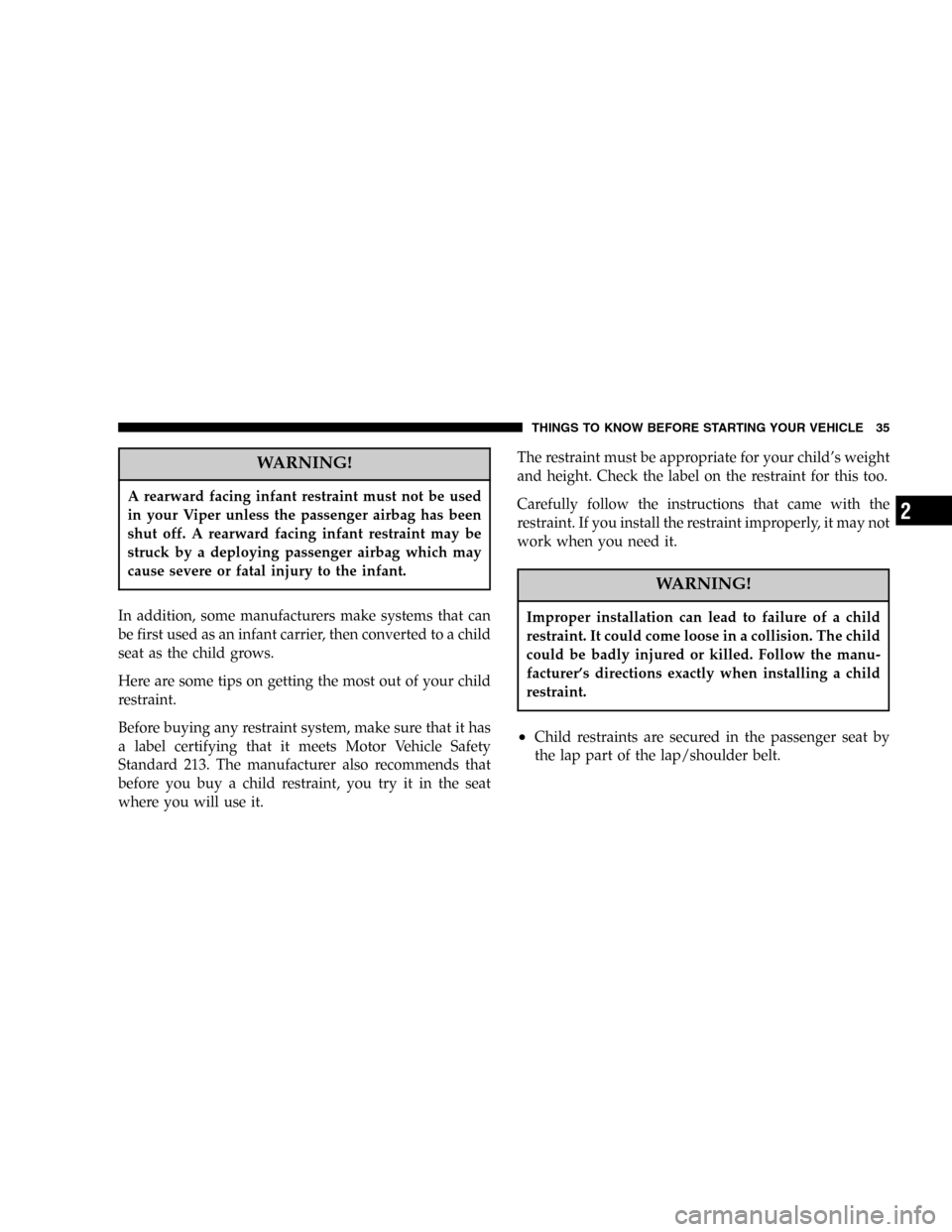Page 35 of 264

WARNING!
A rearward facing infant restraint must not be used
in your Viper unless the passenger airbag has been
shut off. A rearward facing infant restraint may be
struck by a deploying passenger airbag which may
cause severe or fatal injury to the infant.
In addition, some manufacturers make systems that can
be first used as an infant carrier, then converted to a child
seat as the child grows.
Here are some tips on getting the most out of your child
restraint.
Before buying any restraint system, make sure that it has
a label certifying that it meets Motor Vehicle Safety
Standard 213. The manufacturer also recommends that
before you buy a child restraint, you try it in the seat
where you will use it.The restraint must be appropriate for your child’s weight
and height. Check the label on the restraint for this too.
Carefully follow the instructions that came with the
restraint. If you install the restraint improperly, it may not
work when you need it.
WARNING!
Improper installation can lead to failure of a child
restraint. It could come loose in a collision. The child
could be badly injured or killed. Follow the manu-
facturer’s directions exactly when installing a child
restraint.
•Child restraints are secured in the passenger seat by
the lap part of the lap/shoulder belt.
THINGS TO KNOW BEFORE STARTING YOUR VEHICLE 35
2
Page 72 of 264
Then push the safety catch handle located under the front
edge of the hood toward the right. Raise the front of the
hood.NOTE:Assist props will raise the hood to a normal
customer usage position. If greater access is required, the
hood may be pushed up at the front, raising the hood
beyond the initial opening height. Simply pull the hood
down to close it.
CAUTION!
Do not leave the hood open in areas where strong
gusts of wind are likely. Such a place might be by the
side of the road where large trucks pass by. Strong
gusts of wind may damage your hood. Always close
the hood in such situations.
Hood Safety Catch
72 UNDERSTANDING THE FEATURES OF YOUR VEHICLE
Page 94 of 264

2. Press the“H”button to set hours or the“M”button to
set minutes. The time setting will increase each time you
press a button.
RADIO GENERAL INFORMATION
Radio Broadcast Signals
Your new radio will provide excellent reception under
most operating conditions. Like any system, however, car
radios have performance limitations, due to mobile op-
eration and natural phenomena, which might lead you to
believe your sound system is malfunctioning. To help
you understand and save you concern about these“ap-
parent”malfunctions, you must understand a point or
two about the transmission and reception of radio sig-
nals.
Two Types of Signals
There are two basic types of radio signals... AM or
Amplitude Modulation, in which the transmitted sound
causes the amplitude, or height, of the radio waves to
vary... and FM or Frequency Modulation, in which the
frequency of the wave is varied to carry the sound.
Electrical Disturbances
Radio waves may pick up electrical disturbances during
transmission. They mainly affect the wave amplitude,
and thus remain a part of the AM reception. They
interfere very little with the frequency variations that
carry the FM signal.
AM Reception
AM sound is based on wave amplitude, so AM reception
can be disrupted by such things as lightning, power lines
and neon signs.
94 UNDERSTANDING YOUR INSTRUMENT PANEL
Page 123 of 264
Tire Sizing Chart
EXAMPLE:
Size Designation:
P= Passenger car tire size based on U.S. design standards
�....blank....�= Passenger car tire based on European design standards
LT= Light Truck tire based on U.S. design standards
T= Temporary Spare tire
31= Overall Diameter in Inches (in)
215= Section Width in Milimeters (mm)
65= Aspect Ratio in Percent (%)
—Ratio of section height to section width of tire.
10.5= Section Width in Inches (in)
R= Construction Code
—�R�means Radial Construction.
—�D�means Diagonal or Bias Construction.
15= Rim Diameter in Inches (in)
STARTING AND OPERATING 123
5